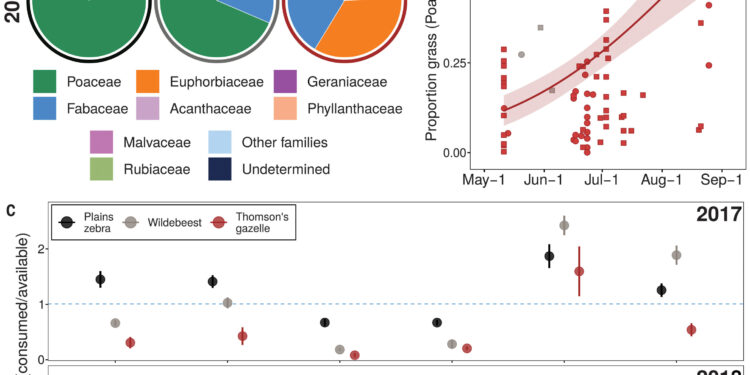Differential consumption of plant taxa of varying nutritional quality. Credit: Science (2024). DOI: 10.1126/science.adg0744
Overturning the prevailing theory of why and how mass multi-species migrations are occurring in Serengeti National Park, Wake Forest University researchers have confirmed that the multi-million-strong wildebeest population is growing herds of zebras compete for the most nutrient-rich grasses.
The resulting study, “Interplay of Competition and Facilitation in grazing succession by migrant Serengeti herbivores,” appears in Science.
For decades, biologists believed that the major grazing populations of the Serengeti – the zebra, then the wildebeest, and finally the Thomson’s gazelle – each paved the way for the small herbivores that followed, making it easier for them to access the plants that they preferred.
This study paints a different picture of the Serengeti landscape. Based on the largest and most comprehensive data analysis to date, this is the first study to combine information from camera traps, GPS collars on individual animals, dietary analysis and satellites that track the effects of fire and precipitation on grasslands.
The research team, led by T. Michael Anderson, a biology professor at Wake Forest University, demonstrates that wildebeest and zebra compete for the best parts of the tall grasses that cover the Serengeti. Once these two grazing populations move, the gazelle can then access the flowering plants and shrubs growing beneath the grass cover.
“Zebras basically feed on large quantities of food. They need a large amount of vegetation to meet their energy needs,” explained Anderson, the study’s principal investigator and corresponding author. “If they stayed behind the wildebeest, the wildebeest would simply consume all the vegetation and the zebra would not be able to meet these energetic demands. This observation was novel and we call it the push-pull hypothesis for the succession of pastures. Instead of facilitation, there is upstream competition.”
The zebra population numbers around 200,000 in the Serengeti, while the wildebeest exceed 1.3 million.
“It’s like a huge lawn mower,” Anderson said. “They have a huge effect on herbaceous biomass.”
The Serengeti is the ideal setting for such a study. Since many mass multi-species migrations on the planet have been eliminated, the movements of zebras, wildebeest and gazelles are unique.
Fire weakens but precipitation strengthens species associations during pastoral succession. Credit: Science (2024). DOI: 10.1126/science.adg0744
Generally, three factors can influence mass migration patterns of herbivores: competition for food; facilitation, or the act of one species improving foraging opportunities for another; and predation, where grazing animals form mixed herds to avoid being eaten.
Competition influences the larger migration of Serengeti species, but facilitation comes into play. While the wildebeest push the zebras out in competition for food, the larger species make it easier for the gazelles to reach rare herbaceous plants, flowering plants, which provide them with the most nutrition. Later in the season, the gazelle feeds on young grasses that grow back in the wake of zebra and wildebeest grazing.
Anderson said the Serengeti findings have applications around the world, where scientists are trying to restore the vast grasslands where plants and animals co-evolved. Because the Serengeti still functions as it did hundreds of thousands of years ago, its management can help inform projects like American Prairie.
“If we want to learn how to manage these ecosystems in the face of global climate change and increasing anthropogenic effects, we will need to learn from these mechanisms,” he said.
The research team included Staci Hepler, Robert J. Erhardt and Robert Sketch of the Department of Statistical Sciences at Wake Forest University, as well as Jeffrey Muday of the Department of Biology.
Both Anderson and Hepler, one of the project’s statisticians, said collaboration between departments led to much better results after data analysis. Understanding biology, Hepler said, allowed him to create statistical models for the project.
“Hypotheses around competition, facilitation and predation have been around for a long time, but they are difficult to validate with generally available data,” she explained. “Our collaboration required many conversations with the biologists explaining the processes and theories, and me explaining the modeling we were doing, so that the models developed could actually test the hypotheses. You need to have collaborations to make sure you are meeting the right question. questions.”
Ricardo M. Holdo and Jason E. Donaldson of the University of Georgia also contributed; J. Grant C. Hopcraft and Thomas A. Morrison of the University of Glasgow; Matthew C. Hutchinson of the University of California Merced; Sarah E. Huebner and Craig Packer of the University of Minnesota; Issack N. Munuo of the Serengeti Wildlife Research Institute; and Meredith S. Palmer, Johan Pansu, and Robert M. Pringle of Princeton University.
Anderson and several co-authors on the paper are using similar data to examine parasite dynamics in Serengeti herbivores, with the goal of determining how nematodes, or parasites living in the guts of grazers, move across the landscape. The results could help understand how these parasites are transmitted to domestic animals living on the edge of the national park.
More information:
T. Michael Anderson et al, Interaction of competition and facilitation in grazing succession by migrant herbivores of the Serengeti, Science (2024). DOI: 10.1126/science.adg0744. www.science.org/doi/10.1126/science.adg0744
Provided by Wake Forest University
Quote: A different picture of the Serengeti: Competition for food drives the planet’s remaining mass migration of herbivores (February 15, 2024) retrieved February 15, 2024 from
This document is subject to copyright. Apart from fair use for private study or research purposes, no part may be reproduced without written permission. The content is provided for information only.



